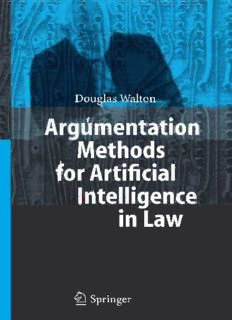
Argumentation Methods for Artificial Intelligence in Law PDF
Preview Argumentation Methods for Artificial Intelligence in Law
(cid:1)(cid:2)(cid:3)(cid:4)(cid:5)(cid:6)(cid:7)(cid:8)(cid:9)(cid:8)(cid:10)(cid:11)(cid:7) (cid:12)(cid:6)(cid:8)(cid:13)(cid:11)(cid:14)(cid:15) (cid:16)(cid:11)(cid:2) (cid:1)(cid:2)(cid:8)(cid:10)(cid:16)(cid:10)(cid:17)(cid:10)(cid:9)(cid:18) (cid:19)(cid:7)(cid:8)(cid:6)(cid:18)(cid:18)(cid:10)(cid:3)(cid:6)(cid:7)(cid:17)(cid:6) (cid:10)(cid:7) (cid:20)(cid:9)(cid:21) (cid:22)(cid:11)(cid:4)(cid:3)(cid:18)(cid:9)(cid:15) (cid:23)(cid:9)(cid:18)(cid:8)(cid:11)(cid:7) (cid:1)(cid:2)(cid:3)(cid:4)(cid:5)(cid:6)(cid:7)(cid:8)(cid:9)(cid:8)(cid:10)(cid:11)(cid:7) (cid:12)(cid:6)(cid:8)(cid:13)(cid:11)(cid:14)(cid:15) (cid:16)(cid:11)(cid:2) (cid:1)(cid:2)(cid:8)(cid:10)(cid:16)(cid:10)(cid:17)(cid:10)(cid:9)(cid:18) (cid:19)(cid:7)(cid:8)(cid:6)(cid:18)(cid:18)(cid:10)(cid:3)(cid:6)(cid:7)(cid:17)(cid:6) (cid:10)(cid:7) (cid:20)(cid:9)(cid:21) (cid:23)(cid:10)(cid:8)(cid:13) (cid:24)(cid:25) (cid:26)(cid:10)(cid:3)(cid:4)(cid:2)(cid:6)(cid:15) (cid:1) (cid:2) (cid:27)(cid:2)(cid:11)(cid:16)(cid:6)(cid:15)(cid:15)(cid:11)(cid:2) (cid:22)(cid:2)(cid:28) (cid:22)(cid:11)(cid:4)(cid:3)(cid:18)(cid:9)(cid:15) (cid:23)(cid:9)(cid:18)(cid:8)(cid:11)(cid:7) (cid:29)(cid:7)(cid:10)(cid:30)(cid:6)(cid:2)(cid:15)(cid:10)(cid:8)(cid:31) (cid:11)(cid:16) (cid:23)(cid:10)(cid:7)(cid:7)(cid:10) (cid:6)(cid:3) (cid:22)(cid:6) (cid:9)(cid:2)(cid:8)(cid:5)(cid:6)(cid:7)(cid:8) (cid:11)(cid:16) (cid:27)(cid:13)(cid:10)(cid:18)(cid:11)(cid:15)(cid:11) (cid:13)(cid:31) (cid:23)(cid:10)(cid:7)(cid:7)(cid:10) (cid:6)(cid:3)! (cid:12)(cid:9)(cid:7)(cid:10)(cid:8)(cid:11)"(cid:9) #$% (cid:24)&’ ((cid:9)(cid:7)(cid:9)(cid:14)(cid:9) (cid:14)(cid:28)(cid:21)(cid:9)(cid:18)(cid:8)(cid:11)(cid:7))(cid:4)(cid:21)(cid:10)(cid:7)(cid:7)(cid:10) (cid:6)(cid:3)(cid:28)(cid:17)(cid:9) (cid:19)*%+,-. $,/0.,(cid:24)/-(cid:25)1,- * (cid:2)(cid:10)(cid:7)(cid:3)(cid:6)(cid:2) %(cid:6)(cid:2)(cid:18)(cid:10)(cid:7) 2(cid:6)(cid:10)(cid:14)(cid:6)(cid:18)"(cid:6)(cid:2)(cid:3) +(cid:6)(cid:21) 3(cid:11)(cid:2)4 (cid:19)*%+,-$ ’1(cid:25),$,/0.,(cid:24)/-(cid:25)1,$ * (cid:2)(cid:10)(cid:7)(cid:3)(cid:6)(cid:2) %(cid:6)(cid:2)(cid:18)(cid:10)(cid:7) 2(cid:6)(cid:10)(cid:14)(cid:6)(cid:18)"(cid:6)(cid:2)(cid:3) +(cid:6)(cid:21) 3(cid:11)(cid:2)4 (cid:20)(cid:10)"(cid:2)(cid:9)(cid:2)(cid:31)(cid:11)(cid:16)((cid:11)(cid:7)(cid:3)(cid:2)(cid:6)(cid:15)(cid:15)((cid:11)(cid:7)(cid:8)(cid:2)(cid:11)(cid:18)+(cid:4)(cid:5)"(cid:6)(cid:2)5(cid:24)../’(cid:24)1(cid:25)6- 7(cid:13)(cid:10)(cid:15) (cid:21)(cid:11)(cid:2)4 (cid:10)(cid:15) (cid:15)(cid:4)"8(cid:6)(cid:17)(cid:8) (cid:8)(cid:11) (cid:17)(cid:11) (cid:31)(cid:2)(cid:10)(cid:3)(cid:13)(cid:8)(cid:28) (cid:1)(cid:18)(cid:18) (cid:2)(cid:10)(cid:3)(cid:13)(cid:8)(cid:15) (cid:9)(cid:2)(cid:6) (cid:2)(cid:6)(cid:15)(cid:6)(cid:2)(cid:30)(cid:6)(cid:14)! (cid:21)(cid:13)(cid:6)(cid:8)(cid:13)(cid:6)(cid:2) (cid:8)(cid:13)(cid:6) (cid:21)(cid:13)(cid:11)(cid:18)(cid:6) (cid:11)(cid:2) (cid:9)(cid:2)(cid:8) (cid:11)(cid:16) (cid:8)(cid:13)(cid:6) (cid:5)(cid:9)(cid:8)(cid:6)(cid:2)(cid:10)(cid:9)(cid:18) (cid:10)(cid:15) (cid:17)(cid:11)(cid:7)(cid:17)(cid:6)(cid:2)(cid:7)(cid:6)(cid:14)! (cid:15) (cid:6)(cid:17)(cid:10)(cid:16)(cid:10)(cid:17)(cid:9)(cid:18)(cid:18)(cid:31) (cid:8)(cid:13)(cid:6) (cid:2)(cid:10)(cid:3)(cid:13)(cid:8)(cid:15) (cid:11)(cid:16) (cid:8)(cid:2)(cid:9)(cid:7)(cid:15)(cid:18)(cid:9)(cid:8)(cid:10)(cid:11)(cid:7)! (cid:2)(cid:6) (cid:2)(cid:10)(cid:7)(cid:8)(cid:10)(cid:7)(cid:3)! (cid:2)(cid:6)(cid:4)(cid:15)(cid:6) (cid:11)(cid:16) (cid:10)(cid:18)(cid:18)(cid:4)(cid:15)(cid:8)(cid:2)(cid:9)(cid:8)(cid:10)(cid:11)(cid:7)(cid:15)! (cid:2)(cid:6)(cid:17)(cid:10)(cid:8)(cid:9)(cid:8)(cid:10)(cid:11)(cid:7)!"(cid:2)(cid:11)(cid:9)(cid:14)(cid:17)(cid:9)(cid:15)(cid:8)(cid:10)(cid:7)(cid:3)!(cid:2)(cid:6) (cid:2)(cid:11)(cid:14)(cid:4)(cid:17)(cid:8)(cid:10)(cid:11)(cid:7)(cid:11)(cid:7)(cid:5)(cid:10)(cid:17)(cid:2)(cid:11)(cid:16)(cid:10)(cid:18)(cid:5)(cid:11)(cid:2) (cid:10)(cid:7)(cid:9)(cid:7)(cid:31)(cid:11)(cid:8)(cid:13)(cid:6)(cid:2) (cid:21)(cid:9)(cid:31)!(cid:9)(cid:7)(cid:14) (cid:15)(cid:8)(cid:11)(cid:2)(cid:9)(cid:3)(cid:6) (cid:10)(cid:7)(cid:14)(cid:9)(cid:8)(cid:9) "(cid:9)(cid:7)4(cid:15)(cid:28)(cid:22)(cid:4) (cid:18)(cid:10)(cid:17)(cid:9)(cid:8)(cid:10)(cid:11)(cid:7)(cid:11)(cid:16)(cid:8)(cid:13)(cid:10)(cid:15) (cid:4)"(cid:18)(cid:10)(cid:17)(cid:9)(cid:8)(cid:10)(cid:11)(cid:7)(cid:11)(cid:2) (cid:9)(cid:2)(cid:8)(cid:15)(cid:8)(cid:13)(cid:6)(cid:2)(cid:6)(cid:11)(cid:16)(cid:10)(cid:15) (cid:6)(cid:2)(cid:5)(cid:10)(cid:8)(cid:8)(cid:6)(cid:14)(cid:11)(cid:7)(cid:18)(cid:31)(cid:4)(cid:7)(cid:14)(cid:6)(cid:2)(cid:8)(cid:13)(cid:6) (cid:2)(cid:11)(cid:30)(cid:10)(cid:15)(cid:10)(cid:11)(cid:7)(cid:15) (cid:11)(cid:16)(cid:8)(cid:13)(cid:6)9(cid:6)(cid:2)(cid:5)(cid:9)(cid:7)((cid:11) (cid:31)(cid:2)(cid:10)(cid:3)(cid:13)(cid:8)(cid:20)(cid:9)(cid:21)(cid:11)(cid:16)*(cid:6) (cid:8)(cid:6)(cid:5)"(cid:6)(cid:2)’!-’6/!(cid:10)(cid:7)(cid:10)(cid:8)(cid:15)(cid:17)(cid:4)(cid:2)(cid:2)(cid:6)(cid:7)(cid:8)(cid:30)(cid:6)(cid:2)(cid:15)(cid:10)(cid:11)(cid:7)!(cid:9)(cid:7)(cid:14) (cid:6)(cid:2)(cid:5)(cid:10)(cid:15)(cid:15)(cid:10)(cid:11)(cid:7)(cid:16)(cid:11)(cid:2) (cid:4)(cid:15)(cid:6)(cid:5)(cid:4)(cid:15)(cid:8)(cid:9)(cid:18)(cid:21)(cid:9)(cid:31)(cid:15)"(cid:6)(cid:11)"(cid:8)(cid:9)(cid:10)(cid:7)(cid:6)(cid:14)(cid:16)(cid:2)(cid:11)(cid:5)* (cid:2)(cid:10)(cid:7)(cid:3)(cid:6)(cid:2),:(cid:6)(cid:2)(cid:18)(cid:9)(cid:3)(cid:28):(cid:10)(cid:11)(cid:18)(cid:9)(cid:8)(cid:10)(cid:11)(cid:7)(cid:15)(cid:9)(cid:2)(cid:6)(cid:18)(cid:10)(cid:9)"(cid:18)(cid:6)(cid:16)(cid:11)(cid:2) (cid:2)(cid:11)(cid:15)(cid:6)(cid:17)(cid:4)(cid:8)(cid:10)(cid:11)(cid:7)(cid:4)(cid:7)(cid:14)(cid:6)(cid:2) (cid:8)(cid:13)(cid:6)9(cid:6)(cid:2)(cid:5)(cid:9)(cid:7)((cid:11) (cid:31)(cid:2)(cid:10)(cid:3)(cid:13)(cid:8)(cid:20)(cid:9)(cid:21)(cid:28) * (cid:2)(cid:10)(cid:7)(cid:3)(cid:6)(cid:2)(cid:10)(cid:15)(cid:9) (cid:9)(cid:2)(cid:8)(cid:11)(cid:16)* (cid:2)(cid:10)(cid:7)(cid:3)(cid:6)(cid:2)*(cid:17)(cid:10)(cid:6)(cid:7)(cid:17)(cid:6);%(cid:4)(cid:15)(cid:10)(cid:7)(cid:6)(cid:15)(cid:15)(cid:12)(cid:6)(cid:14)(cid:10)(cid:9) (cid:15) (cid:2)(cid:10)(cid:7)(cid:3)(cid:6)(cid:2)(cid:11)(cid:7)(cid:18)(cid:10)(cid:7)(cid:6)(cid:28)(cid:17)(cid:11)(cid:5) <* (cid:2)(cid:10)(cid:7)(cid:3)(cid:6)(cid:2)%(cid:6)(cid:2)(cid:18)(cid:10)(cid:7)=2(cid:6)(cid:10)(cid:14)(cid:6)(cid:18)"(cid:6)(cid:2)(cid:3)(cid:24)../ (cid:27)(cid:2)(cid:10)(cid:7)(cid:8)(cid:6)(cid:14)(cid:10)(cid:7)9(cid:6)(cid:2)(cid:5)(cid:9)(cid:7)(cid:31) 7(cid:13)(cid:6) (cid:4)(cid:15)(cid:6) (cid:11)(cid:16) (cid:3)(cid:6)(cid:7)(cid:6)(cid:2)(cid:9)(cid:18) (cid:14)(cid:6)(cid:15)(cid:17)(cid:2)(cid:10) (cid:8)(cid:10)(cid:30)(cid:6) (cid:7)(cid:9)(cid:5)(cid:6)(cid:15)! (cid:2)(cid:6)(cid:3)(cid:10)(cid:15)(cid:8)(cid:6)(cid:2)(cid:6)(cid:14) (cid:7)(cid:9)(cid:5)(cid:6)(cid:15)! (cid:8)(cid:2)(cid:9)(cid:14)(cid:6)(cid:5)(cid:9)(cid:2)4(cid:15)! (cid:6)(cid:8)(cid:17)(cid:28) (cid:10)(cid:7) (cid:8)(cid:13)(cid:10)(cid:15) (cid:4)"(cid:18)(cid:10)(cid:17)(cid:9)(cid:8)(cid:10)(cid:11)(cid:7) (cid:14)(cid:11)(cid:6)(cid:15)(cid:7)(cid:11)(cid:8)(cid:10)(cid:5) (cid:18)(cid:31)!(cid:6)(cid:30)(cid:6)(cid:7)(cid:10)(cid:7)(cid:8)(cid:13)(cid:6)(cid:9)"(cid:15)(cid:6)(cid:7)(cid:17)(cid:6)(cid:11)(cid:16)(cid:9)(cid:15) (cid:6)(cid:17)(cid:10)(cid:16)(cid:10)(cid:17)(cid:15)(cid:8)(cid:9)(cid:8)(cid:6)(cid:5)(cid:6)(cid:7)(cid:8)!(cid:8)(cid:13)(cid:9)(cid:8)(cid:15)(cid:4)(cid:17)(cid:13)(cid:7)(cid:9)(cid:5)(cid:6)(cid:15)(cid:9)(cid:2)(cid:6)(cid:6)>(cid:6)(cid:5) (cid:8)(cid:16)(cid:2)(cid:11)(cid:5) (cid:8)(cid:13)(cid:6)(cid:2)(cid:6)(cid:18)(cid:6)(cid:30)(cid:9)(cid:7)(cid:8) (cid:2)(cid:11)(cid:8)(cid:6)(cid:17)(cid:8)(cid:10)(cid:30)(cid:6)(cid:18)(cid:9)(cid:21)(cid:15)(cid:9)(cid:7)(cid:14)(cid:2)(cid:6)(cid:3)(cid:4)(cid:18)(cid:9)(cid:8)(cid:10)(cid:11)(cid:7)(cid:15)(cid:9)(cid:7)(cid:14)(cid:8)(cid:13)(cid:6)(cid:2)(cid:6)(cid:16)(cid:11)(cid:2)(cid:6)(cid:16)(cid:2)(cid:6)(cid:6)(cid:16)(cid:11)(cid:2)(cid:3)(cid:6)(cid:7)(cid:6)(cid:2)(cid:9)(cid:18)(cid:4)(cid:15)(cid:6)(cid:28) 2(cid:9)(cid:2)(cid:14)(cid:17)(cid:11)(cid:30)(cid:6)(cid:2),(cid:22)(cid:6)(cid:15)(cid:10)(cid:3)(cid:7)5&(cid:2)(cid:10)(cid:17)(cid:13)?(cid:10)(cid:2)(cid:17)(cid:13)(cid:7)(cid:6)(cid:2)!2(cid:6)(cid:10)(cid:14)(cid:6)(cid:18)"(cid:6)(cid:2)(cid:3) *(cid:27)(cid:19)+--0.(cid:24)1/6 60@$-/$,/ 0 $ (cid:24) - .A(cid:27)(cid:2)(cid:10)(cid:7)(cid:8)(cid:6)(cid:14)(cid:11)(cid:7)(cid:9)(cid:17)(cid:10)(cid:14),(cid:16)(cid:2)(cid:6)(cid:6) (cid:9) (cid:6)(cid:2) For Karen With Love Contents Introduction..........................................................................................................xi Acknowledgments..............................................................................................xvii Chapter1:InformalLogicMethodsforLaw.....................................................1 1. BasicsofArgumentDiagramming.............................................................2 2. Araucaria....................................................................................................5 3. LegalOriginsofArgumentDiagramming..................................................8 4. ArgumentationSchemes...........................................................................10 5. Enthymemes..............................................................................................14 6. BurdenofProof........................................................................................16 7. TypesofDialogue.....................................................................................21 8. CommitmentOperationsinDialogues......................................................28 9. LegalandEverydayArgumentation.........................................................30 10. TheLevelofDifficultyoftheProblems...................................................31 Chapter2:GeneralizationsinLegalReasoning...............................................35 1. TheNecessityandDangerofGeneralizations..........................................36 2. TheFallacyofHastyGeneralization........................................................39 3. GeneralizationsinEvidenceLaw.............................................................42 4. ArgumentationSchemes...........................................................................44 5. AnalysisoftheCranberryCaskCase.......................................................48 6. DeductiveandInductiveGeneralizations.................................................54 7. TheThirdTypeofGeneralization............................................................56 8. DefeasibleGeneralizationsandArgumentsfromIgnorance....................63 9. AbstractionandtheDefeasibleQuantifier................................................67 10. EvaluatingArgumentationBasedonGeneralizations..............................71 Chapter3:DefeasibleReasoninginDialogueSystems ...................................75 1. CommonArgumentationSchemesinLegalEvidence..............................76 2. DefeasibleArguments...............................................................................78 3. ArgumentsBasedonCaseComparison....................................................83 4. TheoriesofDefeasibleReasoning............................................................86 5. ComputationalDialecticsforLegalArgumentation.................................89 6. FormalDialogueSystems.........................................................................92 7. LackofKnowledgeInferences.................................................................96 8. OtherArgumentationSchemesinEvidenceLaw...................................103 9. DialogueConditionsforDefeasibleArguments.....................................108 10. TheDialecticalApproachtoDefeasibleArguments...............................110 VIII Contents Chapter4:RelevanceDeterminationsofLegalEvidence.............................115 1. LogicalRelevance...................................................................................116 2. LegalRelevance......................................................................................117 3. ExamplesofRelevanceDeterminations.................................................120 4. DeterminationofRelevancebyArgumentExtrapolation.......................125 5. ProbativeWeightandEnthymemes........................................................129 6. ConditionalRelevance............................................................................132 7. SummaryoftheMethod.........................................................................137 8. TheProblemofDiagnosingFallaciesofRelevance...............................138 9. LegalRelevanceasaProceduralConcept..............................................141 Chapter5:MethodsAppliedtoProblemsofEvidence..................................143 1. Case-BasedReasoning............................................................................144 2. ArgumentDiagrammingforCase-BasedReasoning..............................147 3. WitnessTestimonyasEvidence.............................................................150 4. Examination............................................................................................152 5. CircumstantialEvidence.........................................................................157 6. AbductiveReasoning..............................................................................159 7. ForensicEvidence...................................................................................162 8. CharacterEvidence.................................................................................167 9. EvaluationofEvidence...........................................................................169 Chapter6:DialecticalExplanationinAI .......................................................173 1. SystemsforExplanationinComputing..................................................174 2. PhilosophicalViewsofExplanation.......................................................178 3. AReviewoftheLogicofGeneralizations..............................................183 4. LogicalandPragmaticAspectsofanExplanation.................................186 5. ExplanationandArgument.....................................................................192 6. ThePragmaticsofExplanation...............................................................195 7. EvaluatingExplanationsasBetterorBest..............................................199 8. DifferentKindsofUnderstanding..........................................................202 9. UnderstandingandtheClarifyingFunction............................................205 10. MainFeaturesoftheNewDialecticalModel.........................................208 Chapter7:ArgumentInventionforProofPreparation................................213 1. ArgumentInventionasaSearchProcess................................................214 2. AnEasyCaseofArgumentInvention....................................................218 3. BreachofContractCase.........................................................................222 4. RelevanceandInvention.........................................................................225 5. BuildingaMethodofArgumentInvention.............................................230 6. ClassifyingandFormalizingSchemes....................................................233 7. StudyingCausalSchemes.......................................................................236 8. TenComponentsofLegalArgumentation..............................................240 9. FutureProblemsforResearch.................................................................242 10. AProceduralModelofLegalArgumentation........................................244 Contents IX References..........................................................................................................249 Index...................................................................................................................261 Introduction During a recent visit to China to give an invited lecture on legal argumentation I wasaskedaquestionaboutconventionalopinioninwesterncountries.Iflegalrea- soningisthoughttobeimportantbythosebothinsideandoutsidethelegalprofes- sion, why does there appear to be so little attention given to the study of legal logic? This was a hard question to answer. I had to admit there were no large or well-established centers of legal logic in North America that I could recommend as places to study. Going through customs in Vancouver, the customs officer askedwhatIhadbeendoinginChina.ItoldhimIhadbeenaspeakerataconfer- ence. He asked what the conference was on. I told him legal logic. He asked whethertherewassuchathing.1Hewastryingtobefunny,butIthoughthehada goodpoint.Peoplewillquestionwhetherthereissuchathingas“legallogic”,and somerecent veryprominent trials give the question some backinginthecommon opinion.Buthavingthoughtoverthequestionofwhysolittleattentionappearsto be giventolegallogicasamainstreamsubjectinwesterncountries,IthinkInow haveananswer.Theansweristhatwehavebeenlookinginthewrongplace.We have traditionally looked to formal deductive and inductive models of legal rea- soning,andtheresults, while far frominsignificant,especiallyas astarting point, have just not taken us far enough to deal effectively with the kind of reasoning that is fundamental to law. This is defeasible reasoning, the kind of reasoning in which a rule or generalization that is subject to exceptions is applied to a single case,producinga plausible inferencethatcanfailinsome cases, yetcanstillpro- videevidencetosupportaconclusion. Thisbookmovestoadifferentmodel,andadifferentsetofmethods,thatshow great promise in dealing more effectivelywith defeasible reasoning. In this book, tools for argument analysis and evaluation that have been developed in informal logic and refined in artificial intelligence are applied to some central problems of defeasible reasoning in law. These methods were originally developed in argu- mentation studies and informal logic in order to provide tools to help students think more critically, for example when tryingtoanalyze and evaluate controver- sialargumentsofthekindtypicallystudiedinaphilosophycourse.Theyprovedto be especiallysuccessful in analyzing arguments of the kind associated with tradi- tionalinformalfallacies,likeappealtoexpertopinion.Suchargumentswereprob- lematic in the past because theyare defeasible, and thus prone to failure in some 1 Thequestioncanbetakeninvariousways.Itcouldbetakenassuggestingthatthekind ofargumentationusedintrials,especiallyfamousonesreportedinthepress,isnotlogi- cal.This couldbetakenas a negativecommentonthecurrentstateof law,or evenon themethodsusedbytriallawyers.Ontheotherhand,thereisalegaltraditionthatthere isnosuchthingaslegallogic.Thayer(1889,p.142)suggestedthattherearenospecial rules of logical inference unique to law when he wrote, “there is no law for reasoning otherthanwhatisfoundinthelawsofthought”.Thusthephrase‘legallogic’mayseem tobeanoxymoroneventomanylawyersandjudges. xii Introduction instances, even though they can provide support for a conclusion in other in- stances. Meantime, the field of computing, especially artificial intelligence, be- came centrally preoccupied with such defeasible arguments. Hence the next de- velopmentwasthatsomeinthecomputingfieldstartedtotakeaninterestinthese newmethods,andtostarttryingtorefinethemintoformspreciseenoughthatthey could help with problems in artificial intelligence. This synergy between the two fields led to collaboration and cross-fertilization of results. Now artificial intelli- genceisregardedasthemainareaofapplicationofargumentationtheory. This book proceeds with the hypothesis that the next most important test bed for argumentation is legal reasoning. Argumentation is based on a pragmatic ap- proachinwhichthe use ofanargumentis studiedinadialoguecontext.Anargu- mentisseennotjustasanarbitrarilyselectedsetofpremisesandasingleconclu- sion, but also as taking part in an orderly conversational exchange between two parties in which one is offering reasons to support a conclusion the other has doubtsabout,orneedstobeconvincedtoaccept.Thisapproachseesanargument not onlyasasetofpropositions,butassuchasetusedfor somepurposeinadia- logue context. Thus the approach can be called pragmatic in that it sees an argu- mentas usedin somecontext. Thisapproach can be immediatelyseentofit legal argumentationnaturallyandextremelywell,if onethinks ofthe kindofargumen- tation typically found in a trial setting. There are two sides, there is a conflict of opinions,andeachofthempresentsargumentstosupportitssideandraisedoubts about the argument put forward bythe other side. Of course, there is more going on in a trial than this. There are many participants and there are specific proce- duralrules that varyfromonejurisdictiontoanother.Still,once youstarttothink of it,lawis anaturalandhighlypromisingfieldforthe pragmaticapproachtoar- gumentation. Not only does law stand to profit greatly from this new approach, butthefieldofargumentationcanfindlotsofhighlyinterestingandimportantex- amplesandcasestudiesofarguments,likethosefoundinfamoustrials. Following up this line of thinking, I ventured to write a pioneering book (Walton,2002)thattriedtheexperimentofapplyingargumentationtoolsthenbe- ingdevelopedtoacentralfieldoflaw,that ofevidence.Althoughlegalreasoning hadoftenbeenthoughtimportantasafieldofstudy,especiallyasappliedtorules of evidence, this field had never seemed to attain much status, or come up with importantresults,intheway,forexample,socialstudies of witnesstestimonyhad done. Wigmore diagrams have never been fashionable in law, despite Wigmore’s status as a scholar of evidence in law, and deductive and inductive models of ar- gument,thedominantonesinlogicforsolong,didn’tapplytolegalreasoningina waythatwasturningouttobeallthatusefulinleadingtopowerfultechniquesfor theevaluationofevidence.Thewaveofunjustconvictioncasesledsomecriticsto concludethatevidence law was “adrift”(Damaska, 1997). Theentrypointfor ar- gumentation was this central notion in law that at trial evidence is admitted as relevant and then evaluated through the trial process. These methods were under developmentbothinartificialintelligenceandargumentationresearch,duringand after the period the book (Walton, 2002) was being written and published. These new developments have advanced the analysis of legal argumentation in several waysindicatedbythetopicscoveredinthisbook.
Description: